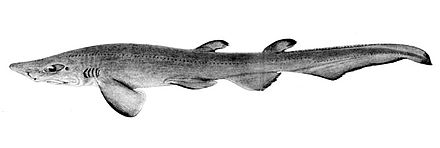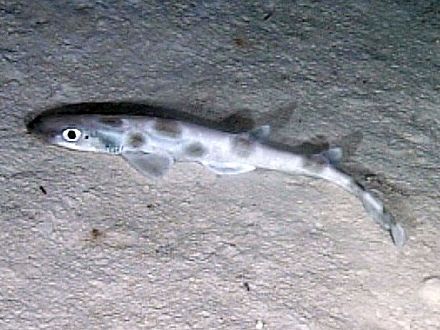Galeus
Galeus is a genus of catshark, belonging to the family Scyliorhinidae, commonly known as sawtail catsharks in reference to a distinctive saw-toothed crest of enlarged dermal denticles, found along the upper edges of their caudal fins.[3] They are found in the Atlantic, the western and central Pacific, and the Gulf of California, inhabiting deep waters at or close to the sea floor. Members of this genus are rather small, slim sharks with firm bodies and thick, rough skin. Their heads are usually fairly long and pointed, and have large mouths with well-developed furrows at the corners. They have large pectoral and anal fins, and two similar dorsal fins placed well back. Many species are ornately patterned with dark saddles and/or blotches. Sawtail catsharks feed on various invertebrates and fishes, and may be either egg-laying or live-bearing. These harmless sharks are sometimes caught as bycatch but are of minimal commercial value.
Galeus, derived from the Greek galeos meaning "shark", is one of the oldest carcharhiniform generic names. It was first used in a binomial by Constantine Samuel Rafinesque in his 1810 Caratteri di alcuni nuovi generi e nuove specie di animali (principalmente di pesci) e piante della Sicilia: con varie osservazioni sopra i medesimi.[4] Rafinesque listed G. melastomus, G. vulpecula (=Alopias vulpinus), G. mustelus (=Mustelus mustelus), and G. catulus (=Scyliorhinus canicula). Subsequently, in 1816 Georges Cuvier used Galeus to refer to the genus presently known as Galeorhinus, and in 1818 William Elford Leach used Galeus to refer to genus presently known as Mustelus. As a result, 19th century authors generally used Galeus for the tope sharks, and Pristiurus, coined by Charles Lucien Bonaparte in 1834, for the sawtail catsharks.[3]
Rafinesque might have intended G. mustelus to be the type species for Galeus, but of his listed species he furnished a description only for G. melastomus. Therefore, in 1908 Henry Weed Fowler designated G. melastomus as the type species of Galeus, establishing the genus to contain the sawtail catsharks.[5] Pristiurus became a junior synonym, though it continued to appear in scientific literature for some time after. Fowler's definition of Galeus gained widespread acceptance after Henry Bryant Bigelow and William Charles Schroeder's 1948 taxonomic review.[3][6] In 1952, Philip Orkin advocated that Pristiurus take precedence over Galeus, based on David Starr Jordan and Barton Warren Evermann's (possibly questionable) designation of G. mustelus as a type species for Galeus in 1896.[7] Leonard Compagno and most other recent authors have not upheld his proposal, in the interests of taxonomic stability.[3]

